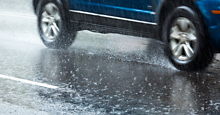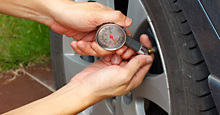
Properly maintained tires help prevent accidents
Autumn rains can turn familiar routes into an oily racetrack. How can you help prevent your vehicle from slip-sliding along fall and winter roadways?
Tires are your vehicle’s first line of defense against dicey road conditions. Quality tires that are properly maintained can help prevent accidents and improve driving performance.
According to Dan Zielinski of the Rubber Manufacturer's Association, the key is proper maintenance.
Zielinski recommends regular tire inspection—not just a cursory glance to see if you have a flat. Look in and around the tire for damage and wear.
"Families stuff everything into their cars before going on vacation," Zielinski cautioned. "Extra weight increases tire heat and risk of failure."
Underinflated tires also create problems. As it flattens out, the thin unprotected sidewall makes contact with the road and could cause a blowout. The increased road friction decreases fuel economy.
"Never fix a tire that has damage to the sidewall," Zielinski said. “Tires are engineered to handle a lot of stress as long as they are maintained properly. Once the integrity of components is damaged, tires ultimately will come apart.”
Overinflated tires generate heat that, over time, can damage tires. The risk of under inflated tires is made worse during hot summer months when the outside heat can add to the stress caused by under inflation.
"A tire is a complex composite structure with fabric and steel components,” said Jim Davis, spokesperson for The Goodyear Tire & Rubber Co. “There are countless variations as these many components are tweaked, depending upon the intended performance features to emphasize in each product.”

Use a guage to ensure proper tire inflation
Tires are one of the hardest working integral parts of your vehicle. They must support heavy loads under extreme conditions such as heat, cold, sudden braking, cornering—while providing a smooth, quiet ride. Increasing one aspect of the performance triangle can affect the other two.
“All of this has to happen in many different weather conditions, temperatures, loads, speeds and on a variety of road surfaces,” Davis said. “Tire manufacturers have to balance product design with a ‘performance triangle’—rolling resistance, tread wear and traction.”
For example, drivers in upper state New York may want “winter tires” with tread that contains traction grooves for better grip on snowy roads and rubber that remains somewhat pliable in freezing temperatures
Drivers in temperate climates such as Southern California can use “all weather” tires that have tread patterns for rain yet offer a smooth ride. All weather tires have tread that tends to last longer than the soft rubber compounds found in winter tires.
Top 10 tire visual inspections and considerations when traveling for the holidays:
- Are you tires underflated? Do sidewalls touch the road surface? If so, you are risking a blowout. Experts say never fix sidewall damage including nail punctures. Replace the tire instead.
- Do you travel often in the snow? Look for tires with tread design that provides good traction on snow and ice-covered roads.
- Bald spots on the tires? Insufficient tread can prevent your vehicle from stopping properly and may cause skidding.
- How much have you loaded into your vehicle? It could cause a tire blowout. Check the tire information placard or owner’s manual for the maximum recommended load for the vehicle.
- Check for cracks, bulges and uneven tire wear. Such signs of fatigue may contribute to tire failure.
- Rotate tires regularly. This helps prevent uneven wear and may uncover problems with tire balancing or alignment. Rotation method varies as to vehicle you drive and tire (front-wheel vs. rear-wheel drive, conventional vs. steel-belted tires). Check manufacturer guidelines.
- Fixing a flat? Ask for plugs and patches when fixing a flat, not just plugs. Plugs may come loose and deflate the tire.
- Are you tires overinflated? Use a tire gauge and find out. Premature tire wear and make tires more susceptible to road hazard damage.
- Live in a mild climate? Consider a general “all weather” tire designed for long tread life and comfortable riding.
- Driver a high performance vehicle? Consider tires with race-inspired tread compounds and innovative tread designs, good enough to handle a day at the track.
Copyright © 2024 by Sensible Driver. All rights reserved.